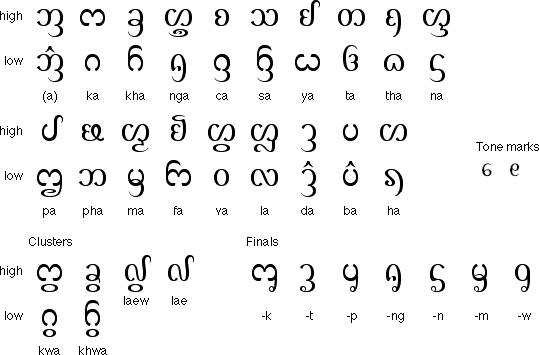Origin
The New (Simplified) Tai Lue script was developed in China during the 1950s. It is based on the Old (Traditional) Tai Lue script, which had been in use since about 1200 AD. Between 1950 and the early 1980s the Chinese government promoted the new script as a replacement for the old script. However since the 1980s the Tai Lue in China have been allowed to choose to teach either the new or the old script. The new script is used exclusively in Jinghong, so could be called the New Jinghong Tai Lue script, and is used for shop and street signs. Few people can read it.The traditional Tai Lue script, which is very similar to the Lanna alphabet, is still used in Burma, Laos, Thailand and Vietnam.
Notable features
- Type of writing system: syllabic alphabet
- Direction of writing: left to write in horizontal lines
- Each consonant letter has a high and low form, which combined with the presence or absence of the two tones marks, is used to indicate the six tones of the Lue language
- Some consonants have a final form which is used at the end of a syllable.
- The letters lae and the laew are shorthand for writing the /l/ plus the /ae/ and the /l/ plus the /aew/.
Used to write:
Lue (a.k.a. Tai Lu, Lü, Lu, Dai Le, Xishuangbanna Dai, Pai-i) a language spoken mainly in the southern Chinese province of Yunnan by about 260,000 people. There are also 265,000 speakers in Burma, 70,000 in Thailand, 20,000 in Laos and 3,000 in Vietnam.Consonants

Vowels
Numerals
Sample
Links
Information about Tai Lue, and more sample textshttp://www.seasite.niu.edu/tai/TaiLue/
Free Tai Lue fonts
http://scripts.sil.org/DaiBannaSIL
Profile of the Tai Lue (Dai) people
http://www.infomekong.com/tai_lue_secondary.htm
No comments:
Post a Comment
Note: Only a member of this blog may post a comment.